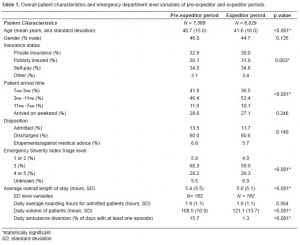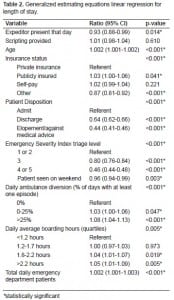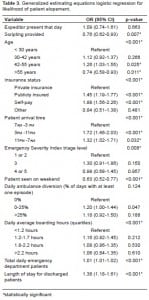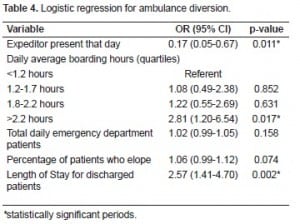| Author | Affiliation |
|---|---|
| Daniel A. Handel, MD, MPH | Oregon Health & Science University |
| O. John Ma, MD | Oregon Health & Science University |
| Judi Workman, MS, RN | Oregon Health & Science University |
| Rongwei Fu, PhD | Oregon Health & Science University |
ABSTRACT
Introduction:
Our hypothesis was that an individual whose primary role was to assist with patient throughput would decrease emergency department (ED) length of stay (LOS), elopements and ambulance diversion. The objective of this study was to measure how the use of an expeditor affected these throughput metrics.
Methods:
This pre-and post-intervention study analyzed ED patients ≥ 21-years-old between June 2008 and June 2009, at a level one trauma center in an academic medical center with an annual ED census of 40,000 patients. We created the expeditor position as our study intervention in December 2008, by modifying the job responsibilities of an existing paramedic position. An expeditor was on duty from 1PM–1AM daily. The pre-intervention period was June to November 2008, and the post-intervention period was January to June 2009. We used multivariable to assess the impact of the expeditor on throughput metrics after adjusting for confounding variables.
Results:
We included a total of 13,680 visits in the analysis. There was a significant decrease in LOS after expeditor implementation by 0.4 hours, despite an increased average daily census (109 vs. 121, p<0.001). The expeditor had no impact on elopements. The probability that the ED experienced complete ambulance diversion during a 24-hour period decreased from 55.2% to 16.0% (OR:0.17, 95%CI:0.05–0.67).
Conclusion:
The use of an expeditor was associated with a decreased LOS and ambulance diversion. These findings suggest that EDs may be able to improve patient flow by using expeditors. This tool is under the control of the ED and does not require larger buy-in, resources, or overall hospital changes.
INTRODUCTION
Contrary to the media portrayal of the emergency department (ED), patients commonly experience lulls in their treatment during the course of an ED visit. These are known as “non-value added steps” since they add little to the care that the patient receives.1 For example, after a patient is triaged, the patient often waits to be brought back to a room. After the initial assessment, the patient may wait during the diagnostic testing and treatment phases. Finally, when the physician reviews the information and makes a disposition decision, the patient may wait to either be discharged or admitted. It is during these down times when the attention to patient care wanes and delays are experienced.
Anticipating these delays can result in a smoother, more efficient operations model. In a restaurant, the maître d’ controls the flow of patrons. Their role is to ensure that guests who arrive are seated as quickly as possible, that their needs are met, and that the table is turned over rapidly and efficiently for the next customer. With this model in mind, our ED created a new position to be similarly mindful of patient flow. We refer to this role as an expeditor. The expeditor’s primary responsibility was to ensure that patient care moved forward. This role did not involve any additional personnel resources; instead, it expanded the role of existing ED paramedics. Prior to this study, paramedics helped in the ED with basic medication administration and starting intravenous (IV) injections. We felt that paramedics would be well suited for the role as an expeditor because their clinical training allows them to assist with the initiation of care when needed. We chose paramedics rather than the charge nurse so that the charge nurse could continue to focus on the overall flow of the ED. The expeditor communicated with and reassessed patients in the waiting room, roomed patients as directed by the charge nurse, and assisted with ambulance arrivals. While the patient was in a treatment room, the expeditor monitored how well their pain was being controlled and provided analgesics as directed by the nurse. Expeditors also placed IVs, drew labs, and ran point-of-care tests. The expeditor assisted with the discharge process by removing IVs and helping the patient get dressed. For admitted patients, the expeditor facilitated patient transport to inpatient units.
Given that this new role focused on the throughput of patients, the hypothesis of this study was that the presence of the expeditor would decrease ED length of stay (LOS), elopements, and ambulance diversion. LOS has been found in other studies to be a proxy for patient satisfaction, along with elopement or left without being seen (LWBS) rates.2,3 These terms have been used interchangeably to define patients that have either left before being seen by a provider and/or before their treatment has been complete. For the purposes of this study, we define elopements as any patient who leaves before being seen by a provider or before the patient’s treatment in the ED is complete. Patients who left against medical advice (AMA) were defined as patients who had a particular treatment plan recommended to them by the provider (such as hospital admission), but decided to not comply with this plan and be discharged from the ED.
METHODS
Study Design and Setting
This was a pre-and post- intervention cohort study designed to assess the impact of an expeditor on ED LOS, elopements and ambulance diversion. We chose these variables as objective measures of ED throughput based on the conceptual model of the input, throughput, and output of patients.4
In December 2008, we selected ED paramedics and trained them in their new role as expeditors. Prior to this, the charge nurse oversaw the flow of patients through the ED. Since the expeditor position was a modification of an existing one, it did not entail adding new personnel. ED staff members assumed the previous responsibilities of ED paramedics. Expeditors worked from 1PM–1AM daily from January to June 2009. We excluded December 2008, from our analysis because we were training expeditors during this time. The pre-intervention period was June 1 to November 30, 2008, and the post-intervention period was January 1 to June 30, 2009. The expeditor’s responsibilities were explained during the training period. Expeditors were expected to communicate with patients in the waiting room after they were triaged and to reassess them every 45 minutes. Expeditors advised patients of anticipated wait times and explained why delays were occurring. In addition, expeditors roomed patients as directed by the charge nurse and prepared the patient for evaluation. Expeditors also assisted with ambulance arrivals. Additional tasks included administering medications, placing IVs, and suture or staple removal. Lastly, the expeditor monitored all patients waiting for an inpatient bed and proactively addressed any barriers delaying their transfer.
We conducted the study at an ED with an annual census of 40,000 patients in a Level one trauma center. The ED is part of an academic medical center in a city of approximately 500,000 people. The hospital has 534 inpatient beds. We included all ED patients 21-years-old and older in the analysis, which accounted for approximately 23% of the patient population during this period. Patients younger than 21-years-old were not included because they were seen in the separate pediatric ED, which has a distinct throughput process. Our facility’s Institutional Review Board approved the study.
Methods of Measurement
We used retrospective data from our electronic health record (Epic; Verona, WI). All patient identifiers were removed prior to analysis. We analyzed two patient level outcome measures including the patient’s LOS (in hours) and whether or not the patient eloped. The ED level outcome measure we used was whether or not ambulance diversion occurred that day. The primary independent variable was the intervention period, i.e., whether or not the expeditor was present that day. Expeditors were present daily during the study period. Potential confounders and predictors include both patient level and ED level daily variables. Patient level variables were used for patient level outcomes and included triage acuity (Emergency Severity Index 1–5), gender, age, time of arrival, type of insurance (private, public [Medicare, Medicaid], self-pay, and other), disposition (for LOS model only), and whether or not the patient was seen on a weekend or weekday. In addition, we provided scripting to some patients to notify them of the longest time a patient was currently waiting. This was included as a patient level variable. ED level daily variables represented crowding and overall volume. Both variables were used for patient and ED level outcomes. The variables included: average LOS for both discharged and admitted patients (only for elopement and diversion outcomes), total number of patients, percent of time the ED was on complete ambulance diversion (only for LOS and elopement outcomes), and the daily average of hours patients boarded in the ED while waiting for an inpatient bed. Since inpatient hospital occupancy was not available, we used daily boarding hours as a proxy to measure delays in getting patients admitted. No specific criteria existed for complete ambulance diversion. The decision to use ambulance diversion was made by ED attendings and the charge nurse. For the elopement and ambulance diversion models, we analyzed the average LOS for discharged and admitted patients separately rather than together since the LOS for discharged patients was within the control of the ED. Another ED level variable was the percentage of patients who eloped each day. We calculated this for consideration in the diversion model. We included the variable of month in all models to adjust for temporal fluctuations.
Primary Data Analysis
We compared differences in patient characteristics and ED daily variables pre-vs. post-intervention using a two-sided t-test for continuous variables and a chi square test for categorical variables. The unit of analysis for LOS and elopement was visit. We used a generalized estimating equation’s (GEE) linear regression to assess the impact of intervention for LOS. We used logistic regression to assess the impact of intervention for elopement. We applied the GEE approach to control for clustering within subjects who had more than one ED visit. For LOS, the outcome variable was log-transformed to satisfy the assumption of normality. Therefore, the exponentiated coefficients were interpreted as the ratio of LOS between the two levels in comparison. For example, the exponentiated coefficient for the expeditor represented the ratio of
Mean LOS Before Expeditor/ Mean LOS After Expeditor
For continuous variable, it is the ratio of LOS for each unit increase of that variable. A ratio <1 indicated a decrease in LOS, and a ratio >1, indicated an increase of LOS. We reported this ratio in our results section. We also performed a sensitivity analysis to look at the impact of an expeditor on LOS for admitted and discharged patients, separately. Since the results were similar, we only reported results on LOS for all patients. For ambulance diversion, we performed a logistic regression with the unit of analysis as day. For all models, we investigated associations between outcome and each independent variable in univariate analyses. Variables with a p-value of ≤ 0.20 were then considered in the multivariate model. A p-value of less than 0.05 was considered significant in the final model. We allowed important confounding variables to remain in the model even if p > 0.05. In addition, we assessed for linearity between outcome and continuous variables for each model. If linearity was not satisfied, the continuous variable was categorized and entered into the model as a categorical variable. We used Stata v10.0 (StataCorp, College Station, TX) for all data analysis.
RESULTS
We included a total of 10,030 patients accounting for 13,680 ED visits in the analysis. The mean age for all patients in the study was 40.9-years-old (± 15.0). A summary of patient characteristics and daily variables is available in Table 1.

The mean LOS (standard deviation) was 5.4 (±5.5) hours before the intervention and 5.0 (±5.1) hours after, despite an increased average daily census (Table 1). Based on the GEE linear regression for the logarithmically transformed LOS, the presence of an expeditor had a significant reduction in the LOS. The mean LOS after intervention was 0.93 times (95% CI 0.88–0.99) the mean LOS before intervention (p=0.014). Additional variables associated with a significant reduction in LOS included an ESI acuity of 3 compared to 2 or 1, an ESI of 4 or 5 compared to 2 or 1, patients discharged versus admitted, patients who eloped or left AMA versus admitted, and patients presenting over the weekend. Patients with a significant increase in their LOS included those with public insurance compared to private insurance, days when the ED was on complete ambulance diversion for greater than 25% of the time, and patients who were boarded in upper two quartiles of boarding hours (from 1.8–2.2 hours and > 2.2 hours, respectively) (Table 2).

There were 6.6% and 5.7% of patients who eloped during the pre-and post-expeditor period, respectively (Table 1). After adjusting for confounding variables, the presence of an expeditor had no association with elopements (OR 1.09, 95% CI 0.74–1.61) [Table 3]. Patients who were provided scripting, were older than 55 years, and seen on a weekend were less likely to elope. In contrast, patients between 42 and 55 years of age, publicly insured or self-pay, and presenting between 3 PM and 7 AM, were more likely to elope.

Before the expeditor intervention, the ED experienced ambulance diversion during a 24-hour period with a probability of 55.2%. After the intervention, the probability that the ED experienced ambulance diversion was 16.0%. The impact of the expeditor was significant after controlling for other variables (OR 0.17, 95% CI 0.05–0.67) (Table 4). An increased LOS for discharged patients was also associated with ambulance diversion (OR 2.57, 95% CI 1.41–4.70 for each hour increase).

DISCUSSION
The use of an ED expeditor was associated with decreased LOS and ambulance diversion but not with patient elopements. The expeditor had a significant impact in reducing ambulance diversion over a 24-hour period. Conversely, boarding patients for greater than 2.2 hours and prolonging LOS for discharged patients both increased the odds of ambulance diversion. Since a decrease in the LOS was associated with the presence of the expeditor, it is possible that the expeditor’s role in decreasing LOS transitively led to a decrease in ambulance diversion.
Patients were more likely to elope if they were publicly insured or uninsured compared to those with private insurance. They were also more likely to elope if they were 42–55 years of age compared to those younger than 30-years-old. In addition, patients eloped more frequently during our busiest time of the day from 3PM–11PM. Our study focused on the variable of LOS for discharged patients, since this variable is within the control of the ED. Conversely, patients were less likely to elope during the weekends when fewer patients were seen. As demonstrated in a prior study, the use of scripting at triage had a positive impact on decreasing elopements.5
This was the first study to explore the novel role of an expeditor. A significant impact was demonstrated after taking an existing resource and focusing it on improving the flow of patients. No other studies could be found in the literature that used such a role. Future research should explore techniques from other industries, such as food service and amusement parks to understand how their best practices might apply to the healthcare setting.
Our data suggest that the expeditor had little impact on patients who remained in the waiting room. Prior studies have demonstrated that a physician at triage has decreased elopements and improved patient satisfaction.6–10 It remains to be seen if an expeditor can have a similar impact. Instead, the expeditors’ efforts could have remained more within the treatment area during the patient’s care and when disposition was made. Also, the result of decreased ambulance diversion could have led to a relative increase in patients eloping, as more patients arriving by ambulance would displace patients coming by other means to the waiting room. This could have blunted any improvements seen in terms of a decrease in elopements. There are a number of ED level factors that have been shown to be associated with elopement rates, including ED volume, the number of boarding hours for admitted patients, the percent of patients arriving by ambulance, and LOS for discharged patients.11
LIMITATIONS
Several limitations were inherent to the study. First, there was no proof that the expeditors fulfilled the job description duties completely when they were assigned to a particular shift. This study did not account for variations of individual expeditors who may have been more or less effective in their role. In addition, there is concern that other improvement initiatives, including the use of scripting at triage to provide wait time notification, may have been confounding variables despite controlling for this and other variables in the models. Throughout both the pre-and post-intervention periods, an ED full-capacity protocol was undergoing modification to address surges in patient volume. Since the protocol was applied inconsistently during this time, it is unclear what affect this may have had on outcomes. Given limitations in how the data could be collected, only daily variables could be used for the analysis when hourly variables might have been able to provide further detail. Also, since the study was conducted in one academic ED, the results may not apply to other EDs.
CONCLUSION
In summary, the creation of an expeditor in our ED was associated with decreased patient LOS and ambulance diversion, but not elopements. Further definition and standardization of the role may ensure that the expeditor is involved in the care of ED patients in the waiting room, which may drive down elopements.
Footnotes
Supervising Section Editor: Larry Raney, MD
Submission history: Submitted: July 19, 2010; Revision received September 21, 2010; Accepted November 29, 2010.
Reprints available through open access at http://escholarship.org/uc/uciem_westjem.
Address for Correspondence: Daniel A. Handel, MD, MPH, Department of Emergency Medicine, Oregon Health & Science University School of Medicine
Email: handeld@ohsu.edu
Conflicts of Interest: By the WestJEM article submission agreement, all authors are required to disclose all affiliations, funding sources, and financial or management relationships that could be perceived as potential sources of bias. The authors disclosed none.
REFERENCES
1. Liker JK. The Toyota Way: 14 Management Principles from the World’s Greatest Manufacturer.New York: McGraw-Hill Professional; 2004.
2. Bastani A, Anderson W, Spiro O. How long before patients lose their patience? Ann Emerg Med.2008;52(4):S86–S87.
3. Pines JM. The left-without-being-seen rate: an imperfect measure of emergency department crowding. Acad Emerg Med. 2006;13(7):807. 807–808. author reply. [PubMed]
4. Asplin BR, Magid DJ, Rhodes KV, et al. A conceptual model of emergency department crowding.Ann Emerg Med. 2003;42(2):173–180. [PubMed]
5. Handel D, Fu R, Daya M, et al. The use of scripting at triage and its impact on elopements. Acad Emerg Med. 2010;17:495–500. [PubMed]
6. Murrell K, Offerman S, Carl M, et al. Implementation of an emergency department physician in triage system decreases patient wait times and “left without being seen” rates. Acad Emerg Med.2009;16(4):S204–S205.
7. Schlicher N, Proctor T, Rutschilling J, et al. Equivalent treatment times and patient satisfaction seen when physician in triage program staffed by junior and senior physicians. Acad Emerg Med.2009;16(4):S207.
8. Chan TC, Killeen JP, Kelly D, et al. Impact of rapid entry and accelerated care at triage on reducing emergency department patient wait times, lengths of stay, and rate of left without being seen. Ann Emerg Med. 2005 Dec;46(6):491–497. [PubMed]
9. Frohna W, Roseman D, Kratz H, et al. Physician-led care team in triage-a golden solution to crowding. Acad Emerg Med. 2010;17(5):S88.
10. Wiler JL, Gentle C, Halfpenny JM, et al. Optimizing emergency department front-end operations.Ann Emerg Med. 2010;55:142–160. [PubMed]
11. Torres V, Brunett P, Fu R, et al. Leaving without being seen. Boarding, bored, or both? Acad Emerg Med. 2007;14:S54–S55.


